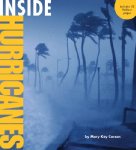Through the Looking Glass Children's Book Reviews
Inside Hurricanes
Nonfiction
For ages 8 to 12
Sterling, 2010 ISBN: 978-1402777806
Though hurricanes can cause a great deal of damage and loss of life, they don’t “come out of nowhere.” These days scientists can use satellite imagery to see hurricanes forming over oceans days or even weeks before they make landfall. Unfortunately, that cannot predict with one hundred percent certainty when and where the hurricane will come on land. Nor can they say, until just before the hurricane makes landfall, how strong it is going to be.
The proper scientific name for this natural phenomenon is a tropical cyclone. In North America people call them hurricanes, but people in other parts of world call them cyclones or typhoons. Tropical cyclones come into being over the warm water belt that is found around the equator. They occur wherever ocean water is warm (at least eighty degrees Fahrenheit or twenty-seven degrees Celsius), and where surface winds converge to create rainclouds that become thunderstorm clouds. The winds both above the storm and at ocean level need to be moving in the same direction, otherwise the storm will be “pulled apart by wind shear.”
If these conditions are met, the storm begins to grow. It starts to rotate, it gains speed to become a tropical storm, and when an eye opens at its center it is considered a full-blown tropical cyclone. These storms certainly disrupt shipping out at sea, but they are particularly destructive when they come on land. Storm surge can flood low lying coastal areas, which is what happened when Hurricane Katrina hit New Orleans. The intensity of such storms determines how much damage is done to natural features and man-made structures. Some hurricanes cause relatively little damage, while others such as the hurricane that hit Galveston in 1900, can lay waste to a whole city.
In this excellent title, which is one in a series of nonfiction books, the author gives young readers an interesting overview of what hurricanes are, where they occur, why they occur, how they affect human populations, and more. Many of the section include pages that fold out or flip up, and remarkable photos and annotated diagrams help readers to better understand the well written text. “I was there” accounts given by people who experienced notable hurricanes give readers a sense of what it might be like to be in the middle of a tropical cyclone in person.




